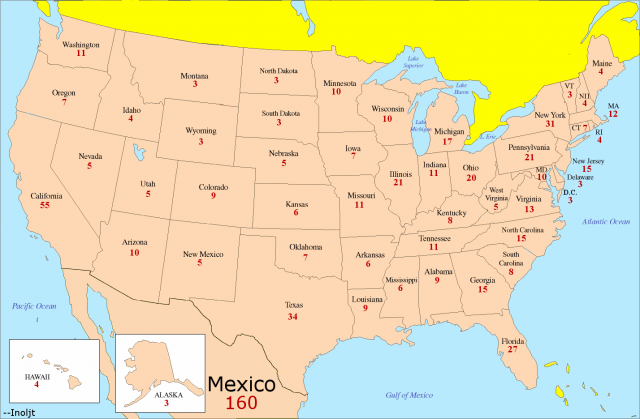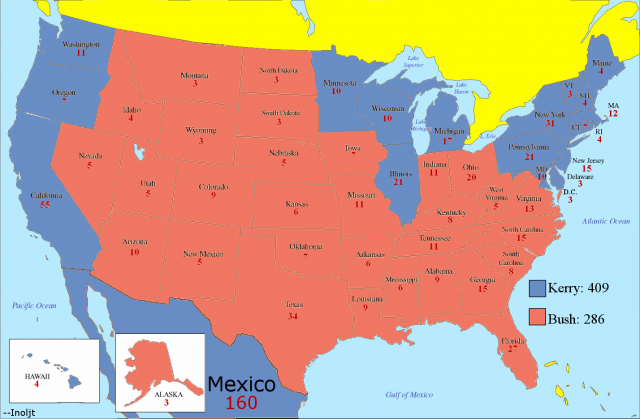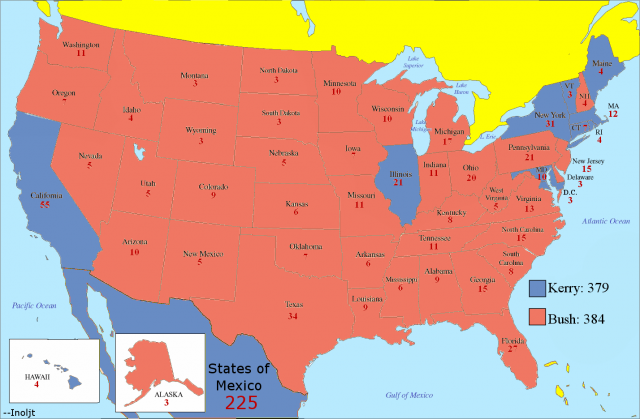Welcome SSPers to Part 2 of my ongoing series about the “38 states of America”. For those that don’t know what I’m referring to, the 38 states of America are a redrawing of the United States based on grouping together of economic, social, and political interests – sometimes referred to as “communities of interest”
The Map:

In part 1 I went through the states in the Northeast Region, with the intention of giving the states ratings a la Charlie Cook, Stewart Rothenburg, et al, with regard to the 2012 presidential election and future federal elections in general. Here’s a quick recap of part 1:
Kennebec – Solid D
Plymouth – Solid D
Mohawk – Toss Up
Hudson – Solid D
Susquehanna – Solid D
Allegheny – Lean D
Chesapeake – Likely D
Appalachia – Solid R
In part 2, we’re going to investigate the states within the Midwest Region. There are 9 states in this region, Erie, Wabash, Mackinac, Dearborn, Osage, Prairie, Superior, Dakota, and Platte.
Erie – (South OH/North KY) – Total vote 2,904,184
Obama – 1,323,907 (45.6%)
McCain – 1,580,277 (54.4%)
PVI – R+7
Rating – Solid Republican
Now here’s a state that I thought would be much more competitive. Erie basically consists of central and southern Ohio as well as parts of western Indiana and most of northern Kentucky. As it turns out, most of the rural areas in this district are absolutely toxic for the Democrats, whether it be in western Ohio, northern Kentucky, or most notably of all the suburbs and exurbs surrounding Cincinnati. In order to win, the democratic candidate would have to find a way to get the margins down in the rural counties while running up big margins in Columbus, Dayton, and Cincinnati. If Columbus and Cincy keep moving leftward this could be competitive by end of the decade, but for now, Safe R.
Mackinac – (Greater Michigan) – Total vote 4,305,104
Obama – 2,571,298 (59.7%)
McCain – 1,733,806 (40.3%)
PVI – D+7
Rating – Solid Democratic
Mackinac state is the opposite of Erie state, one I figured would be more competitive but it turns out to be a democratic stronghold. The trouble here for the republicans is that some of the most republican parts of Michigan get cut out and given to Dearborn, and the state doesn’t extend far enough south into Ohio to pick up the vast red voting populations of the rural west. As a result, the cities like Detroit, Toledo, Lansing, Flint, and Ann Arbor end up basically dominating the state’s politics. The remaining rural areas aren’t all that republican either. Safe for Dems.
Wabash – (Indiana/Kentucky/West IL) – Total vote 3,102,991
Obama – 1,499,893 (48.3%)
McCain – 1,603,098 (51.7%)
PVI – R+5
Rating – Likely Republican
Wabash state is a state based in Indiana and Kentucky, and covers a lot of Midwestern and upper South territory in between. It would seem that this would be more of a republican stronghold than Erie state, but that’s actually not the case, as Obama took over 48% here. He got that margin by running very strongly in the democratic bastions of Indianapolis and Louisville. The rural areas are fairly tough though, especially down in Kentucky and in the suburbs and exurbs around Indy. For the democrat to win they’d have to win big in the cities, and also engage voters in the mid-size cities and college towns like Evansville, Bloomington, Lexington, West Lafayette, and Muncie while not getting killed in the exurbs and rural country. My guess is that this state would get some ads and visits, but if the republican isn’t winning here, he or she is definitely not winning nationally.
Dearborn – (Lake Michigan Corridor) – Total vote 7,104,345
Obama – 4,363,393 (61.4%)
McCain – 2,740,952 (38.6%)
PVI – D+8
Rating – Solid Democratic
Dearborn state surrounds the lower end of Lake Michigan, and it centers on Chicago but is actually a mix of big cities, mid-size towns, and rural area. What little republican base there is in Dearborn seems to be centered on lower western Michigan, northern Indiana’s rural reaches, and the suburbs/exurbs of Milwaukee. Ostensibly Chicago’s collar counties would be an opportunity for some republican votes too, but these areas all went blue in 2008 behind native son Barack Obama. Kerry didn’t do nearly as well as Obama did in this state but I can’t imagine that he took less than 55% in a not so great year. The combination of Madison, Milwaukee, Chicago, and college towns like Kalamazoo, Dekalb, and South Bend is simply too much for any republican to overcome. Safe D.
Osage – (Western IL & Eastern MO) – Total vote 2,486,318
Obama – 1,317,244 (53.0%)
McCain – 1,169,074 (47.0%)
PVI – Even
Rating – Toss Up
Osage state is a quintessential swing state. It consists of most of southern and western Illinois along with most of eastern Missouri. The state is centered on Saint Louis, which is the primary democratic stronghold within the state. Obama was able to carry the state with 53% of the vote in 2008, equaling his national tally, and the PVI is even. The republican base here is in the Missouri rural counties, and to a lesser extent those in central and lower Illinois, as these counties tend to be a little more swingish in national elections. The democrat to win would have to ring up big margins in greater STL and do very well in the river counties just north and south of STL on both sides of the Mississippi. There would be huge money, huge advertising, and many visits given to this state from both sides as this state is probably one of the few that will end up deciding most presidential races.
Prairie – (Iowa & Upper Mississippi Valley) – Total vote 1,600,690
Obama – 915,632 (57.2%)
McCain – 685,058 (42.8%)
PVI – D+4
Rating – Likely Democratic
Prairie state encompasses what amounts to the eastern two-thirds of Iowa combined with the extreme north of Missouri, northwestern Illinois, and southwestern Wisconsin. This district comprises some of the most democratic rural territory in the US outside of New England, and though there aren’t any major cities in the state, the cities that do exist, like Des Moines, Iowa City, and the Quad Cities, all break heavily democratic as well. Still, it’s not an impossible state for the republicans, if they were to pump a lot of effort into Prairie they might be able to turn it red. This is the smallest state so far, so I’m not sure just how a big a deal it would be electorally. I’m calling it Likely D.
Superior – (Upper Midwest MI/WI/MN) – Total vote 4,039,225
Obama – 2,239,234 (55.4%)
McCain – 1,799,991 (44.6%)
PVI – D+2
Rating – Leans Democratic
Superior state stretches across the Canadian frontier of the Midwest from the upper peninsula of Michigan across most of Wisconsin and Minnesota. At first glance, this would seem to be a favorable setup for the republicans with cities like Madison and Milwaukee drawn into nearby Dearborn, but alas, so were their cherry red suburban communities in SE Wisconsin. The rural areas in Wisconsin are actually quite liberal aside from greater Green Bay, and the major metroplex of Minneapolis-St Paul is a real boon to the democratic candidate, as is the iron range of northeastern Minnesota. The key area for the republican candidate is undoubtedly the “Bachmann zone” in the exurbs north and west of Minneapolis. At D+2, this state would be a fight most cycles, similar to the battles fought in the upper Midwest that we’ve seen in the recent past. Lots of time and effort would go into this state.
Dakota – (west MN, most of ND and SD) – Total vote 738,833
Obama – 357,984 (48.5%)
McCain – 380,849 (51.5%)
PVI – R+5
Rating – Likely Republican
Dakota state is roughly similar to the two Dakotas now, shifted slightly eastward into the western reaches of Minnesota. It’s by far the smallest state we’ve seen thus far, and I believe is the smallest state of the lower 36. I figured at the outset that this would be a walkover for the republicans, but surprisingly, Obama took nearly 49% of the vote and finished just 3% behind McCain. Looking at the map, the key region for the democrats in Dakota is the Red River valley, Obama performed very well in the river counties of upper Minnesota as well as in Grand Forks and Fargo on the other side. The Indian reservations are also a source of votes. For the republicans, their strength comes in the western part of the state and from the farmland in general. This state doesn’t provide an abundance of electoral votes and likely wouldn’t swing a presidential race, but would probably see campaign dollars because of its mild competitiveness and extremely cheap media.
Platte – (Central Plains, parts of IA, MO, KS, NE) – Total vote 2,732,639
Obama – 1,258,798 (46.1%)
McCain – 1,473,841 (53.9%)
PVI – R+7
Rating – Safe Republican
Platte state is a mostly rural state right in the heart of the country’s midsection. It encompasses the western third of Iowa and Missouri and the eastern two-thirds of Nebraska and Kansas, along with a very small piece of South Dakota. Just looking at the map, you’d think that the democrats got murdered here in 2008, but that isn’t completely true. Bolstered by very strong performances in places like Kansas City, Omaha, Lincoln, and Lawrence, Barack Obama strung together a fairly surprising 46% of the vote. Now of course the farm country out in these parts is very, very red, and it would be very hard for Team Blue to pick this state off in anything but a great democratic year, but it’s not as impossible as I thought initially. Still, it’s red enough for me to call it Safe R. In a 2010-style year Team Red probably puts up 60% or higher here.
That concludes part 2. In part 3 we’ll look at the Southeast Region.












